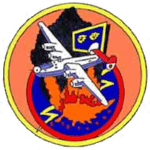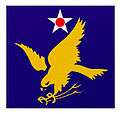451st Air Expeditionary Group
| 451st Air Expeditionary Group | |
|---|---|
|
An MQ-1 Predator taxis for an Operation Enduring Freedom | |
| Active | since 1943 |
| Country |
|
| Branch |
|
| Size | Wing |
| Part of | United States Air Forces Central |
| Garrison/HQ | Kandahar Airfield, Afghanistan |
| Engagements |
World War II European Campaign (1943–1945)
|
| Commanders | |
| Current commander | Col Lucey |
| Insignia | |
| 451st Air Expeditionary Wing emblem |
 |
| 451st Strategic Missile Wing emblem (Approved 29 June 1962)[1] |
|
| Unofficial 451st Bombardment Group emblem[2] |
 |
The 451st Air Expeditionary Group (451 AEG) is a provisional United States Air Force USAFCENT unit. It is assigned to Kandahar Airfield and is also the host unit at Kandahar. It reports to the 455th Air Expeditionary Wing at Bagram Air Base.
The 451 AEG provides an airpower presence in the Afghanistan area of operations. 451st AEW Airmen provide Intelligence, Surveillance and Reconnaissance, Command and Control, RPA operations, and Airborne Datalink capabilities.
During the Cold War, the Strategic Air Command 451st Strategic Missile Wing was the first fully operational HGM-25A Titan I ICBM wing in 1962. During World War II, the wing's predecessor unit, the 451st Bombardment Group was a B-24 Liberator heavy bombardment organization, assigned to Fifteenth Air Force in Italy.
Units
- 62d Expeditionary Reconnaissance Squadron (launch and recovery for MQ-1 Predator and MQ-9 Reaper)[3]
- 73d Expeditionary Air Control Squadron
- 303d Expeditionary Fighter Squadron
- 361st Expeditionary Reconnaissance Squadron
- 430th Expeditionary Electronic Combat Squadron
- 451st Expeditionary Operations Support Squadron
- 772d Expeditionary Airlift Squadron
- 451st Expeditionary Communications Squadron
- 451st Expeditionary Civil Engineering Squadron
- 451st Expeditionary Logistics Readiness Squadron
- 451st Expeditionary Security Forces Squadron
- 451st Expeditionary Force Support Flight
Tenant Units
- 466th Air Expeditionary Squadron
- 809th RED HORSE Squadron
- 777th Expeditionary Prime BEEF Squadron
- 807th Expeditionary Air Support Operations Squadron
History
World War II

Constituted as 451st Bombardment Group (Heavy) on 6 April 1943. Activated on 1 May 1943. Activated as a B-24 Liberator heavy bombardment unit; assigned to II Bomber Command for training. Primarily trained in the midwest. Received deployment orders for the Mediterranean Theater of Operations (MTO) in November 1943.
Deployed to Southern Italy in January 1944; entered combat in January 1944, being assigned to Fifteenth Air Force. Air echelon training in Algeria for several weeks before joining the remainder of the group in Italy. Engaged in very long range strategic bombing missions to enemy military, industrial and transportation targets in Italy, France, Germany, Austria, Hungary, Romania, and Yugoslavia. Attacked such targets as oil refineries, marshalling yards, aircraft factories, bridges, and airfields in Italy, France, Germany, Czechoslovakia, Austria, Hungary, Romania, Bulgaria, Albania, and Greece.
Received a Distinguished Unit Citation for each of three missions: to an aircraft factory at Regensburg on 25 February 1944, to oil refineries and marshalling yards at Ploiești on 5 April 1944, and to an airdrome at Vienna on 23 August 1944; although encountering large numbers of enemy fighters and severe antiaircraft fire during each of these missions, the group fought its way through the opposition, destroyed many interceptors, and inflicted serious damage on the assigned targets.
Infamously responsible for the bombing of a primary school in Milan's neighborhood of Gorla on 20 October 1944 which caused the death of 184 children and their teachers.
At times the group also flew support and interdictory missions. Helped to prepare the way for and participated in the invasion of Southern France in August 1944. Transported supplies to troops in Italy during September 1944. Supported the final advances of Allied armies in northern Italy in April 1945.
Returned to the US in June 1945, forming at Dow Field, Maine. Unit personnel were demobilized throughout the summer of 1945. Inactivated on 26 September 1945.
Cold War
Established as the 451st Strategic Missile Wing (ICBM-Titan) at Lowry Air Force Base, Colorado and organized on 1 July 1961. The wing assumed the missiles, personnel and equipment of the 703d Strategic Missile Wing (Inactivated)[4] The 451st SMW was the first operational HGM-25A Titan I missile wing. Construction on all 18 silos at the six launch complexes was completed by 4 August 1961. On 18 April 1962, Headquarters SAC declared the 724th SMS operational, and 2 days later the first Titan Is went on alert status. A month later, the sister 725th SMS (initially designated the 849th SMS) declared it had placed all nine of its Titan Is on alert status, which marked a SAC first.
On 19 November 1964, Defense Secretary McNamara announced the phase-out of remaining first-generation SM-65 Atlas and Titan I missiles by the end of June 1965. This objective was met. All wing missiles went off alert status on 26 March 1965 and the wing phased down for inactivation. On 25 June 1965, the 724th SMS and 725th SMS were inactivated. SAC removed the last missile from Lowry on 14 April 1965.
Global War on Terrorism

The 451st Air Expeditionary Group was activated in 2002 as part of the Global War on Terrorism, conducting operations from Kandahar Airfield, Afghanistan. The group was responsible for air control of the southern region of Afghanistan, launch and recovery operations for the MQ-1 Predator and MQ-9 Reaper aircraft, the employment of combat search and rescue forces throughout the entire country and ground security and defense of the airfield. Included in the group are safety, logistics, communications, civil engineer.
Due to the growth in size and requirements of the USAF mission at Kandahar, the 451 AEG was enlarged to a wing-level organization, redesignated as the 451st Air Expeditionary Wing (451 AEW) and activated as such on 2 July 2009.[5]
The wing was downsized to a group in January 2014 as part of the Afghanistan drawdown.[6]
Former components:
- 451st Expeditionary Operations Group
- 702d Expeditionary Airlift Squadron (C-27J Spartan, 31 July 2011 – 18 June 2012)[7]
- 451st Expeditionary Maintenance Group
- 451st Expeditionary Aircraft Maintenance Squadron
- 451st Expeditionary Maintenance Squadron
- 451st Expeditionary Mission Support Group
- 651st Air Expeditionary Group
- 26th Expeditionary Rescue Squadron (inactivated 1 January 2014)[8]
- 46th Expeditionary Rescue Squadron (September 2010 - inactivated early 2013)[9][10]
- 651st Expeditionary Aeromedical Evacuation Squadron (inactivated Dec 2013)[11]
Lineage
- 451st Bombardment Group
- Constituted as the 451st Bombardment Group (Heavy) on 6 April 1943
- Activated on 1 May 1943
- Redesignated 451st Bombardment Group, Heavy on 10 May 1943
- Inactivated on 26 September 1945[note 2]
- Consolidated on 31 January 1984 with the 451st Strategic Missile Wing as the 451st Strategic Missile Wing[12]
- 451st Strategic Missile Wing
- Established as the 451st Strategic Missile Wing (ICBM-Titan) 1 July 1961 and activated (not organized)
- Organized 1 July 1961
- Discontinued and inactivated on 25 June 1965[note 3]
- Consolidated on 31 January 1984 with the 451st Bombardment Group
- Redesignated 451st Air Expeditionary Group, converted to provisional status and assigned to Air Combat Command to activate or inactivate as needed on 3 May 2002[12]
- Activated 2 May 2002[13]
- Redesignated 451st Air Expeditionary Wing 2 July 2009[13]
- Redesignated 451st Air Expeditionary Group c. 3 January 2014[13]
Assignments
- II Bomber Command, 1 May 1943
- Second Air Force, 6 October 1943
- 47th Bombardment Wing, c. 11 December 1943
- 49th Bombardment Wing, 7 April 1944
- Air Transport Command, c. 19 June – 16 September 1945
- Strategic Air Command, 26 April 1961 (not organized)
- 13th Air Division (later 13th Strategic Missile Division), 1 July 1961 – 25 June 1965
- Air Combat Command to activate or inactivate as needed[note 4]
- 455th Air Expeditionary Wing, 2 May 2002
- Ninth Air and Space Expeditionary Task Force, 2 July 2009 - presemt
Components
- Groups
- 451st Expeditionary Maintenance Group, 2 July 2009 - 3 January 2014
- 451st Expeditionary Mission Support Group, 2 July 2009 - 3 January 2014
- 451st Expeditionary Operations Group, 2 July 2009 - 3 January 2014
- Squadrons
- 724th Bombardment Squadron (later 724th Strategic Missile Squadron), 1 May 1943 – 26 Sep 1945; 1 July 1961 – 25 June 1965
- 725th Bombardment Squadron (later 725th Strategic Missile Squadron), 1 May 1943 – 26 Sep 1945; 1 July 1961 – 25 June 1965
- 726th Bombardment Squadron, 1 May 1943 – 26 Sep 1945
- 727th Bombardment Squadron, 1 May 1943 – 26 Sep 1945
Stations
|
|
Aircraft
- Consolidated B-24 Liberator 1943–1945
- HGM-25A Titan I 1961–1965
- General Dynamics F-16 Fighting Falcon Post 2002
- Fairchild Republic A-10C Thunderbolt II Post 2002
- Lockheed Martin C-130J Super Hercules Post 2002
- Alenia C-27J Spartan Post 2002
- Northrop Grumman E-11A BACN Post 2002
- Beechcraft U-21 King Air Post 2002
- Sikorsky HH-60G Pave Hawk Post 2002
- Beechcraft MC-12 Huron Post 2002
- General Atomics MQ-1 Predator Post 2002
- General Atomics MQ-9 Reaper Post 2002
References
Notes
- ↑ Aircraft is Consolidated B-24H-30-CF serial 42-50443 displaying 304th Bombardment Wing markings c. 1945. The upper tail surface and circle were red.
- ↑ Group lineage in Maurer, Combat Units, pp. 325-326
- ↑ Wing lineage in Ravenstein, p. 247
- ↑ Assignments through May 2002 in Robertson, Factsheet 451st Air Expeditionary Group.
Citations
- ↑ Ravenstein, p. 247
- ↑ See Maurer, Combat Units, p. 326 (no approved emblem).
- ↑ Tech. Sgt. Renni Thornton, 62d ERS reaches 250K flying hours in AOR, 6/16/2010, 451st Air Expeditionary Wing Public Affairs
- ↑ USAFHRA document 00425998
- ↑ General takes to the sky in Afghanistan, Air Force News Service
- ↑ 451st Air Expeditionary Wing transitions to Group at Kandahar Airfield, 1/15/2014, 455th Air Expeditionary Wing Public Affairs
- ↑ 702d Expeditionary Airlift Squadron deactivates at Kandahar Airfield Archived 2 December 2012 at the Wayback Machine.
- ↑ Rescue squadron deactivates at Camp Bastion, Trevor Martin, 6 January 2014
- ↑ Last rescue squadrons leaving Kandahar, Air Force Times
- ↑ Rescue squadrons close chapter in southern Afghanistan
- ↑ 651st EAES scheduled for deactivation, Capt. Jason Smith, 451st Air Expeditionary Wing Public Affairs
- 1 2 Robertson, Patsy (December 3, 2009). "Factsheet 451 Air Expeditionary Group (ACC)". Air Force Historical Research Agency. Retrieved August 2, 2015.
- 1 2 3 Rihn, SMS Gary J. "451st Air Expeditionary Wing transitions to Group at Kandahar Airfield". Unitrf Dtates Air Force Central Command Public Affairs. Retrieved August 2, 2015.
Bibliography
![]() This article incorporates public domain material from the Air Force Historical Research Agency website http://www.afhra.af.mil/.
This article incorporates public domain material from the Air Force Historical Research Agency website http://www.afhra.af.mil/.
- Hill, Michael. The 451st Bomb Group in World War II: A Pictorial History. Atglen, Pennsylvania: Schiffer Publishing, 2000. ISBN 0-7643-1287-1.
- Maurer, Maurer, ed. (1983) [1961]. Air Force Combat Units of World War II (PDF) (reprint ed.). Washington, DC: Office of Air Force History. ISBN 0-912799-02-1. LCCN 61060979.
- Ravenstein, Charles A. (1984). Air Force Combat Wings, Lineage & Honors Histories 1947-1977 (PDF). Washington, DC: Office of Air Force History. ISBN 0-912799-12-9.
| Wikimedia Commons has media related to 451st Air Expeditionary Group. |



.svg.png)
.svg.png)
.svg.png)
